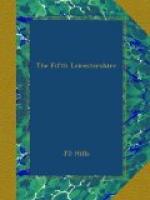On the 20th May our work in the forest came to an end and, as the Brigade was wanted for fatigues nearer the line, we moved by Pommera and Pas to Souastre, a village about three miles from the front trenches. The Sherwood Foresters were at present holding the Divisional front, and our chief task in the new area was digging cable trenches from back Headquarter positions to forward batteries and observation posts, building and stocking ammunition and bomb stores, and assisting in the construction of numerous gun pits. In fact, we were once more preparing as fast as possible for a “big push,” though at the moment it was not quite certain who was going to do the pushing; rumour allotted this task to the 46th Division. The work was very hard, for digging a deep narrow trench, or loading flints at Warlincourt quarries are no light tasks, and the weather made conditions even more difficult than they might otherwise have been. One day it was so hot as to make continuous work for more than a few hours impossible, while the next, there would be three or four torrential rain storms, filling all the trenches, and turning the cross-country tracks to avenues of mud.
However, in spite of our work, we managed to have some football, and the Divisional Commander once more presented a cup. We started well, beating the 5th Lincolnshires in the second round, but then found ourselves opposed to our old rivals, the 4th Battalion, for the Brigade finals. The game caused the keenest excitement, and with the score at two goals all, the enthusiasm through the second half was immense. Unfortunately, there is a fate against our defeating the 4th Battalion, and, just before the end, our opponents managed to score the winning goal.
[Illustration: Lens from the Air (showing Fosse III. and Bois de Riaumont).]
[Illustration: Sketch map of Gommecourt to illustrate the attack of the 1st July 1916. German trenches in RED]
[Illustration: Lt.-Col. J.B.O. Trimble, D.S.O., M.C., with the Officers, Marqueffles Farm, June, 1917.]




